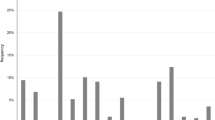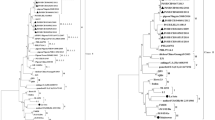Abstract
Erysipelothrix rhusiopathiae causes swine erysipelas (SE), which results in considerable economic loss on pig farms. During SE outbreaks that occurred sporadically from 2008 to 2011 in Japan, new E. rhusiopathiae strains were isolated with a specific surface protective antigen (Spa)A protein characterized by methionine at position 203 and isoleucine at position 257 (M203/I257 SpaA type). To determine whether strains with the M203/I257 SpaA type are still prevalent in Japan, we collected 79 strains of E. rhusiopathiae from pigs showing various SE symptoms from 2012 to 2019 and classified them based on serovar typing, spaA gene sequence analysis, and lineage typing. We found that the majority of recent E. rhusiopathiae strains (59/79) belonged to the serovar 1a strain, and that the M203/I257 SpaA type (56/59) was predominant continuing from 2008 to 2011. Furthermore, serovar 1a strains with IVb-1 and IVb-2 lineages that had been isolated in specific regions of Japan were no longer local but were found across Japan. The pathogenicity of recent isolates tested in mice was not significantly changed when compared to that of previously isolated strains. Our results suggest that recent SE outbreaks were not due to changes in the SpaA protein or to altered virulence of E. rhusiopathiae but were rather caused by the persistent presence of E. rhusiopathiae with the M203/I257 SpaA type.


Similar content being viewed by others
References
Wood RL (1999) Erysipelas. In: Straw BE, D’Allaire S, Mengelin WL, Taylor DJ (eds) Diseases of swine, 8th edn. Iowa State University, Ames, pp 419–441
Wang Q, Chang BJ, Riley TV (2010) Erysipelothrix rhusiopathiae. Vet Microbiol 140(3–4):405–417. https://doi.org/10.1016/j.vetmic.2009.08.012
Takahashi T, Sawada T, Takagi M, Sato K, Kanzaki M, Maruyama T (1984) Serotypes of Erysipelothrix Rhusiopathiae strains isolated from slaughter pigs affected with chronic erysipelas. Nihon Juigaku Zasshi 46(2):149–153. https://doi.org/10.1292/jvms1939.46.149
Takahashi T, Fujisawa T, Tamura Y, Suzuki S, Muramatsu M, Sawada T, Bennno Y, Mitsuoka T (1992) DNA relatedness among Erysipelothrix rhusiopathiae strains representing all twenty-three serovars and Erysipelothrix tonsillarum. Int J Syst Bacteriol 42(3):469–473. https://doi.org/10.1099/00207713-42-3-469
Opriessnig T, Hoffman DL, Harris DL, Gaul SB, Halbur PG (2004) Erysipelothrix rhusiopathiae: genetic characterization of midwest US isolates and live commercial vaccines using pulsed-field gel electrophoresis. J Vet Diagn Invest 16:101–107. https://doi.org/10.1177/104063870401600202
Takahashi T, Nagamine N, Kijima M, Suzuki S, Takagi M, Tamura Y, Nakamura M, Muramatsu M, Sawada T (1996) Serovars of Erysipelothrix strains isolated from pigs affected with erysipelas in Japan. J Vet Med Sci 58(6):587–589. https://doi.org/10.1292/jvms.58.587
Borrathybay E, Gong F, Zhang L, Nazierbieke W (2015) Role of surface protective antigen A in the pathogenesis of Erysipelothrix rhusiopathiae strain C43065. J Microbiol Biotechnol 25(2):206–216. https://doi.org/10.4014/jmb.1407.07058
Imada Y, Goji N, Ishikawa H, Kishima M, Sekizaki T (1999) Truncated surface protective antigen (SpaA) of Erysipelothrix rhusiopathiae serotype 1a elicits protection against challenge with serotypes 1a and 2b in pigs. Infect Immun 67(9):4376–4382
Makino S, Yamamoto K, Murakami S, Shirahata T, Uemura K, Sawada T, Wakamoto H, Morita H (1998) Properties of repeat domain found in a novel protective antigen, SpaA, of Erysipelothrix rhusiopathiae. Microb Pathog 25(2):101–109. https://doi.org/10.1006/mpat.1998.0216
Shimoji Y, Mori Y, Fischetti VA (1999) Immunological characterization of a protective antigen of Erysipelothrix rhusiopathiae: identification of the region responsible for protective immunity. Infect Immun 67(4):1646–1651
Makino SI, Yamamoto K, Asakura H, Shirahata T (2000) Surface antigen, SpaA, of Erysipelothrix rhusiopathiae binds to Gram-positive bacterial cell surfaces. FEMS Microbiol Lett 186(2):313–317. https://doi.org/10.1111/j.1574-6968.2000.tb09123.x
Harada T, Ogawa Y, Eguchi M, Shi F, Sato M, Uchida K, Nakayama H, Shimoji Y (2014) Phosphorylcholine and SpaA, a choline binding protein, are involved in the adherence of Erysipelothrix rhusiopathiae to porcine endothelial cells, but this adherence is not mediated by the PAF receptor. Vet Microbiol 172(1–2):216–222. https://doi.org/10.1016/j.vetmic.2014.04.012
To H, Nagai S (2007) Genetic and antigenic diversity of the surface protective antigen proteins of Erysipelothrix rhusiopathiae. Clin Vaccine Immunol 14(7):813–820. https://doi.org/10.1128/CVI.00099-07
To H, Sato H, Tazumi A, Tsutsumi N, Nagai S, Iwata A, Nagano T (2012) Characterization of Erysipelothrix rhusiopathiae strains isolated from recent swine erysipelas outbreaks in Japan. J Vet Med Sci 74(7):949–953. https://doi.org/10.1292/jvms.11-0533
Uchiyama M, Shimazaki Y, Isshiki Y, Kojima A, Hirano F, Yamamoto K, Kijima M, Nagai H (2016) Pathogenic characterization of Erysipelothrix rhusiopathiae Met-203 type SpaA strains from chronic and subacute swine erysipelas in Japan. J Vet Med Sci 79(1):18–21. https://doi.org/10.1292/jvms.16-0164
Shimoji Y, Yokomizo Y, Sekizaki T, Mori Y, Kubo M (1994) Presence of a capsule in Erysipelothrix rhusiopathiae and its relationship to virulence for mice. Infect Immun 62(7):2806–2810
Shiraiwa K, Ogawa Y, Nishikawa S, Eguchi M, Shimoji Y (2018) Identification of serovar 1a, 1b, and 5 strains of Erysipelothrix rhusiopathiae by a conventional gel-based PCR. Vet Microbiol 225:101–104. https://doi.org/10.1016/j.vetmic.2018.09.014
Nagai S, To H, Kanda A (2008) Differentiation of Erysipelothrix rhusiopathiae strains by nucleotide sequence analysis of a hypervariable region in the spaA gene: discrimination of a live vaccine strain from field isolates. J Vet Diagn Invest 20(3):336–342. https://doi.org/10.1177/104063870802000313
Shiraiwa K, Ogawa Y, Nishikawa S, Nishikawa S, Eguchi M, Shimoji Y (2017) Multiplex PCR assay for the simultaneous detection and differentiation of clonal lineages of Erysipelothrix rhusiopathiae serovar 1a strains currently circulating in Japan. J Vet Med Sci 79(8):1318–1322. https://doi.org/10.1292/jvms.17-0255
Ogawa Y, Shirakawa K, Ogura Y, Ooka T, Nishikawa S, Eguchi M, Hayashi T, Shimoji Y (2017) Clonal lineages of Erysipelothrix rhusiopathiae responsible for acute swine erysipelas in Japan identified by using genome-wide single-nucleotide polymorphism analysis. Appl Environ Microbiol 83(11):e00130-e217. https://doi.org/10.1128/AEM.00130-17
Zou Y, Zhu X, Muhammad HM, Jiang P, Li Y (2015) Characterization of Erysipelothrix rhusiopathiae strains isolated from acute swine erysipelas outbreaks in Eastern China. J Vet Med Sci 77(6):653–660. https://doi.org/10.1292/jvms.14-0589
McNeil M, Gerber PF, Thomson J, Williamson S, Opriessnig T (2017) Serotypes and Spa types of Erysipelothrix rhusiopathiae isolates from British pigs (1987 to 2015). J Vet 225:13–15. https://doi.org/10.1016/j.tvjl.2017.04.012
Forde TL, Kollanandi Ratheesh N, Harvey WT, Thomson JR, Williamson S, Biek R, Opriessnig T (2020) Genomic and immunogenic protein diversity of Erysipelothrix rhusiopathiae isolated from pigs in Great Britain: implications for vaccine protection. Front Microbiol 11:418. https://doi.org/10.3389/fmicb.2020.00418
Zhu W, Wu C, Kang C, Cai C, Wang Y, Li J, Zhang Q, Sun X, Jin M (2018) Evaluation of the protective efficacy of four newly identified surface proteins of E. rhusiopathiae. Vaccine 36:8079–8083. https://doi.org/10.1016/j.vaccine.2018.10.071
Zhu W, Cai C, Li J, Zhang Q, Huan J, Jin M (2019) Characterization of protective antigen CbpB as an adhesion and a plasminogen-binding protein of E. rhusiopathiae. Res Vet Sci 124:352–356. https://doi.org/10.1016/j.rvsc.2019.04.002
Forde TL, Orsel K, Zadoks RN, Biek R, Adams LG, Checkley SL, Davison T, De Buck J, Dumond M, Elkin BT, Finnegan L, Macbeth BJ, Nelson C, Niptanatiak A, Sather S, Schwantje HM, van der Meer F, Kutz SJ (2016) Bacterial genomics reveal the complex epidemiology of an emerging pathogen in Arctic and boreal ungulates. Front Microbiol 7:1759. https://doi.org/10.3389/fmicb.2016.01759
Opriessnig T, Forde T, Shimoji Y (2020) Erysipelothrix spp.: past, present, and future directions in vaccine research. Front Vet Sci 7:174. https://doi.org/10.3389/fvets.2020.00174
Shimoji Y, Shiraiwa K, Tominaga H, Nishikawa S, Eguchi M, Hikono H, Ogawa Y (2020) Development of a multiplex PCR-based assay for rapid serotyping of Erysipelothrix species. J Clin Microbiol. https://doi.org/10.1128/JCM.00315-20
Acknowledgements
The authors thank Drs. Kazumoto Shibuya and Tetsuo Sato for their helpful advice, and Eri Yamazaki for her laboratory assistance. We are grateful to Dr. Yoshihiro Shimoji for his kind offer of some bacterial strains and valuable advice. We are also grateful to the veterinary staff at the prefectural livestock hygiene service centers and pig farms for providing the field samples and valuable information.
Author information
Authors and Affiliations
Contributions
HK and MM conceived and designed the study. MM, YA, and NK performed the sample collections and the laboratory work. MM analyzed the data and wrote the manuscript. CS, HT, AK, and SN provided valuable advice and comments. AK edited the manuscript. All authors read and approved the final manuscript.
Corresponding author
Ethics declarations
Conflict of interest
The authors declare that they have no conflicts of interest.
Additional information
Publisher's Note
Springer Nature remains neutral with regard to jurisdictional claims in published maps and institutional affiliations.
Rights and permissions
About this article
Cite this article
Morimoto, M., Kato, A., Kojima, H. et al. Serovars and SpaA Types of Erysipelothrix rhusiopathiae Isolated from Pigs in Japan from 2012 to 2019. Curr Microbiol 78, 55–66 (2021). https://doi.org/10.1007/s00284-020-02254-2
Received:
Accepted:
Published:
Issue Date:
DOI: https://doi.org/10.1007/s00284-020-02254-2




